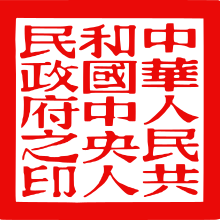Seal of the People's Government of the People's Republic of China
| Seal of the Central People's Government of the People's Republic of China 中华人民共和国中央人民政府之印 | |
|---|---|
 | |
| Armiger | |
| Adopted | 31 October 1949 |
| Relinquished | May 1959 |
| Motto |
中華人民共 |
| Use |
|
The Seal of the Central People's Government of the People's Republic of China (Chinese: 中华人民共和国中央人民政府之印), or the Founding Seal (Chinese: 开国大印), was the national seal of the People's Republic of China from 1949 to 1959. It is no longer in use, and is kept in the National Museum of China.[1]
The seal was designed by Zhang Yuecheng.[2] Earlier in 1949, Zhang Yuecheng would carve the seals for Zhou Enlai and Zhu De, and the seal of the Beijing Municipal People's Government.[3] Zhang Yuecheng was recommended by Qi Yanming to design "The Seal of the Central Government of the People's Republic of China".[3] Zhang then submitted four different designs with four different typefaces for the print of the seal, these were made in the clerical script, the Song, Han seal, and Qin seal. After these designs were finalised, Chairman Mao Zedong selected the design with Song.[3]
Design
[edit]The Seal of the People's Government of the People's Republic of China is cast from brass, with a little ammonium added. The seal has a square base, and a cylindrical handle on the top. The height of the seal base is 2.5 centimetres, and the handle is 10.9 centimetres tall, totalling 13.4 centimetres in height. Its base is 4.5 centimetres wide and 4.5 centimetres long, the perimeter is 18 centimetres. There are no obvious patterns or symbols engraved on the seal other than the face, however there is a slight concave on the handle for better grip. Its inscription 「中華人民共和國中央人民政府之印」, meaning The Seal of the People's Government of the People's Republic of China, is written in the typeface Song, styled from right to left and from top to bottom.[4]
Timeline
[edit]
- 11 June 1949: Zhou Enlai asked Chen Shutong to find a seal maker, regarding the making of seals for the government. Together with Qi Yanming, Chen Shutong decided to recommended Zhang Yuecheng as the official seal maker.
- A few days later: Zhou Enlai gathered Zhang and some experts to discuss and decide the design of the National Seal.
- 27 September 1949: After several months of discussion, four potential seal designs were picked. The four designs mainly differs in font, there was the clerical script, the Song, Han seal, and the Qin seal.
- 1 October 1949: The Central People's Government of the People's Republic of China was established and was set as the cabinet. Central People's Government of the People's Republic of China controlled all the seal used to pass laws, commands, and other authorities proclaimed by the president or the cabinet, including the National Seal.
- 27 October 1949: The Song seal design was approved by Mao Zedong and Zhou Enlai, immediately after the national seal's bill was paid and the making started.
- 31 October 1949: The National Seal was finished and handed to the government.
- September 1949: The cabinet was changed from the Central People's Government of the People's Republic of China to the State Council of the People's Republic of China, and together all the seals are transferred to the new cabinet.
- May 1959: The National Seal was retired by the General Office of the State Council and was sent to the National Museum of China.[3][4][1]
See also
[edit]- Imperial Seal of China
- National Seals of the Republic of China
- Seal of South Korea
- Privy Seal of Japan
- State Seal of Japan
References
[edit]- ^ a b "Seal of the People's Government of the People's Republic of China". Retrieved 4 June 2021.
- ^ "张樾丞奉命篆刻"开国大印"毛泽东亲定用宋体字". 人民网. 12 April 2010. Retrieved 4 June 2019.
- ^ a b c d "张樾丞,一位给新中国治"开国大印"的篆刻泰斗". Sohu. 3 December 2018. Retrieved 28 January 2020.
- ^ a b "新中国第一枚国印诞生记" [A documentary of the first People's Republic of China's National Seals birth] (in Chinese). 14 May 2021. Retrieved 4 June 2021.

